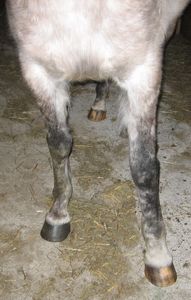Lameness is when a horse has discomfort or pain in its legs or body causing a limp or awkwardness it the stride. It is important to notice lameness in your horse as well as to treat it accordingly. Here are some possible causes of lameness and symptoms to look for:
Biciptal Burstitis: On the front of the shoulder is the “bicipital bursa”. When this area has been injured the horse will have become short strided and lame in the shoulder area. The horse will usually be sensitive around this area and may flinch when the hoof is picked up and the shoulder extended. Treatment: Anti-inflammatory treatments. Local injections by your vet may help.
Capped Elbow\ Knee or Hock (Shoe Boil, Hygroma of the Elbow/Knee): A blow to the point of the elbow/knee/hock causes swelling. Often a horse will lie down on hard ground (putting pressure on the elbow) or catches himself in the elbow with a hoof. The swelling may be slightly warm and puffy but usually does not cause lameness. Swelling usually goes away on its own but the vet can drain and inject the area. In severe cases permanent scar tissue may form. Kicking walls or other hard surfaces often causes capped hocks. Treatment: Your veterinarian can drain the boil. Ask about a donut that can be placed on the pastern to prevent further injury to the elbow. In the case of an affected knee, the vet may recommend stall rest with pressure wraps to reduce further swelling. Possible anti-inflammatory treatments.
Cellulitis: This condition is caused by a puncture wound in the front on hind leg yet it is usually located in the forearm. It is an infection that causes pain and swelling and possibly a mild lameness. Treatment: Clean and disinfect the area making sure the infection can drain properly. Make sure the animals tetanus is up to date (booster?) and antibiotics may be necessary.
DJD (Degenerative Joint Disease, Osteoarthritis): Generally symptoms of DJD are seen in older horses yet it is crucial to note that the damage caused by this condition begins early in a horses life. If severe enough, DJD may cause a young horse to retire. DJD is often seen in the knee. DJD is caused by stress to the joint area resulting in arthritic symptoms and varying degrees of pain and lameness. The resulting damage can never be truly healed and more damage will usually occur. Poor nutrition, poor conformation, trauma to the area, and everyday wear and tear can cause this condition. Treatment: Your veterinarian may recommend surgery. Anti-inflammatory treatments may help. Oral supplements.
Epiphysitis: This is seen in the leg joints of young horses, yet it is usually problematic in the knee. Epiphysitis occurs when the epiphyseal lines are open (they are closed when the horse is mature and finished growing). The area becomes large and inflammed due to a nutritional imbalance or rapid growth. Sometimes the blemish will remain permanent. Treatment: Call the vet. Balance the diet and cut back on high energy feed. Cut back in the training regime.
OCD (Osteochondritis Dissecans): This condition can be located in almost any of the horse’s joints. It is most often seen in young or growing horses. Blood supply to the affected joint area ceases and causes the area to die leaving pieces of cartilage, bone or cysts. This causes pain and lameness. Rapid growth and nutritional imbalance is thought to cause this condition. Treatment: Success of treatment relies on catching this condition as early as possible and therefore minimizing the damage. X-rays identify the problem and usually surgery is needed to remove the pieces causing pain.
Shoulder Sweeny: This is not a serious condition although it may cause mild lameness. It refers to an injured suprascapular nerve which causes loss of muscle mass over a shoulder blade. The horse may be slightly lame but usually learns to deal with the muscle loss and can be worked normally. The affected shoulder looks less full and the shoulder blade is visible under the skin. This condition is permanent.
by Adrianne Lake
